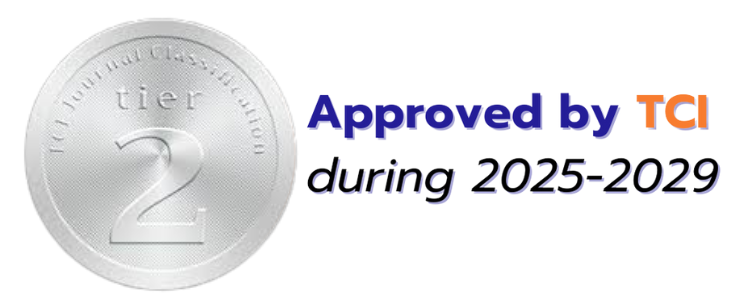การจัดการเรียนรู้ที่เน้นบริบทการสืบสวนนิติวิทยาศาสตร์เพื่อส่งเสริมความสามารถในการสร้างคำอธิบายทางวิทยาศาสตร์ เรื่องพันธุกรรม ของนักเรียนชั้นมัธยมศึกษาปีที่ 3
关键词:
การจัดการเรียนรู้ที่เน้นบริบท, ความสามารถในการสร้างคำอธิบายทางวิทยาศาสตร์, พันธุกรรม摘要
การวิจัยนี้มีวัตถุประสงค์ดังนี้ 1) เพื่อเปรียบเทียบผลสัมฤทธิ์ทางการเรียนเรื่องพันธุกรรม ก่อนเรียนและหลังเรียนของนักเรียนชั้นมัธยมศึกษาปีที่ 3 ที่ได้รับการจัดการเรียนรู้ที่เน้นบริบทการสืบสวนนิติวิทยาศาสตร์ 2) เพื่อเปรียบเทียบความสามารถในการสร้างคำอธิบายทางวิทยาศาสตร์ เรื่องพันธุกรรมกับเกณฑ์ร้อยละ 80 และ 3) เพื่อศึกษาความพึงพอใจต่อการจัดการเรียนรู้ที่เน้นบริบทการสืบสวนนิติวิทยาศาสตร์ ระเบียบวิธีวิจัยเน้นการวิจัยกึ่งทดลองแบบกลุ่มเดียวทดสอบก่อนและหลัง โดยกลุ่มผู้เข้าร่วมวิจัยเป็นนักเรียนชั้นมัธยมศึกษาปีที่ 3 จำนวน 31 คน เครื่องมือวิจัยประกอบด้วย 1) กิจกรรมการเรียนรู้เรียนรู้ที่เน้นบริบทการสืบสวนนิติวิทยาศาสตร์ ประกอบด้วย 3 สถานการณ์ที่สอดคล้องกับเนื้อหาพันธุกรรม 2) แบบวัดผลสัมฤทธิ์ทางการเรียนวิทยาศาสตร์เรื่องพันธุกรรม และ 3) แบบวัดความสามารถในการสร้างคำอธิบายทางวิทยาศาสตร์เกี่ยวกับพันธุกรรม และ 4) แบบสอบถามความพึงพอใจ ผลการวิจัยพบว่า 1) ค่าคะแนนเฉลี่ยผลสัมฤทธิ์ทางการเรียนเรื่องพันธุกรรมของนักเรียนหลังเรียนด้วยการจัดการเรียนรู้ที่เน้นบริบทการสืบสวนนิติวิทยาศาสตร์ วิทยาศาสตร์สูงกว่าก่อนเรียนอย่างมีนัยสำคัญที่ระดับ .01 2) ค่าคะแนนเฉลี่ยความสามารถในการอธิบายทางวิทยาศาสตร์หลังทำกิจกรรมการเรียนรู้สูงกว่าเกณฑ์ร้อยละ 80 อย่างมีนัยสำคัญทางสถิติที่ระดับ .01 และ 3) นักเรียนมีความพึงพอใจต่อการจัดการเรียนรู้ที่เน้นบริบทการสืบสวนนิติวิทยาศาสตร์ อยู่ในระดับมาก ผลการวิจัยนี้แสดงให้เห็นว่า การจัดการเรียนรู้ที่เน้นบริบทการสืบสวนนิติวิทยาศาสตร์ สามารถสร้างความเข้าใจในเนื้อหาและการนำแนวคิดไปใช้อธิบายบริบทด้วยการเน้นการระบุข้อสรุป หลักฐาน และเหตุผลทางวิทยาศาสตร์ที่สัมพันธ์กัน
Downloads
参考
Allen, J., & Rogers, M. P. (2015). Putting ideas on paper: Formulating scientific explanations using the claim, evidence, and reasoning (CER) framework. Science and Children, 53(3), 32–37.
Bennett, J. (2005). Teaching and learning science: A guide to recent research and its applications. Continuum.
Bennett, J., Lubben, F., & Hogarth, S. (2007). Bringing science to life: A synthesis of the research evidence on the effects of context‐based and STS approaches to science teaching. Science Education, 91(3), 347–370. https://doi.org/10.1002/sce.20186
Choi, K., & Lee, H. (2008). Science education in South Korea: Advances in achievement and future challenges. Journal of Science Education and Technology, 17(2), 125–132. https://doi.org/10.1007/s10956-008-9097-0
Gilbert, J. K. (2006). On the nature of “context” in chemical education. International Journal of Science Education, 28(9), 957–976. https://doi.org/10.1080/09500690600702470
Institute for the Promotion of Teaching Science and Technology. (2019a). Guidelines for teaching and learning to develop scientific literacy in the 21st century. Ministry of Education of Thailand. https://www.ipst.ac.th/ipsten
Institute for the Promotion of Teaching Science and Technology. (2019b). Scientific literacy. https://www.ipst.ac.th/news/12216/20210527_project14.html
Keeley, J., Zayac, R., & Correia, C. (2008). Curvilinear relationships between statistics anxiety and performance among undergraduate students: Evidence for optimal anxiety. Statistics Education Research Journal, 7(1), 4–15. https://iaseweb.org/documents/SERJ/SERJ7(1)
_Keeley.pdf
King, D., & Ritchie, S. M. (2012). Learning science through real-world contexts. In B. J. Fraser, K. G. Tobin, & C. J. McRobbie (Eds.), Second international handbook of science education. Springer. https://doi.org/10.1007/978-1-4020-9041-7_6
Kruengthong, T. (2010). Context-based learning in science education: A review of theoretical perspectives and applications in classrooms. IPST Magazine, 38(166), 56-59. [In Thai]
Kuhn, L., & Reiser, B. (2005, April). Students constructing and defending evidence-based scientific explanations. Paper presented at the Annual Meeting of the National Association for Research in Science Teaching, Dallas, TX.
McNeill, K. L., & Krajcik, J. (2008). Scientific explanations: Characterizing and evaluating the effects of teachers' instructional practices on student learning. Journal of Research in Science Teaching, 45(1), 53–78. https://doi.org/10.1002/tea.20201
McNeill, K. L., & Krajcik, J. S. (2011). Supporting grade 5–8 students in constructing explanations in science: The claim, evidence, and reasoning framework for talk and writing. Pearson.
Office of the Basic Education Commission. (2022). The assessment of Thai students' scientific competency based on the Programme for International Student Assessment (PISA). Ministry of Education of Thailand. https://www.pisacenterobec.org/about-me/
Organisation for Economic Co-operation and Development (OECD). (2019). PISA 2018 results. OECD Publishing. https://doi.org/10.1787/5f07c754-en
Parchmann, I., Gräsel, C., Baer, A., Nentwig, P., Demuth, R., & Ralle, B. (2006). Chemie im Kontext: A symbiotic implementation of a context‐based teaching and learning approach. International Journal of Science Education, 28(9), 1041–1062. https://doi.org/10.1080/09500690600563534
Wannagatesiri, T., Fakcharoenphol, W., Laohammanee, K., & Ramsiri, R. (2017). Implication of Context-based Science in Middle School Students: Case of Learning Heat. International Journal of Science, Mathematics and Technology Learning, 24(2), 1-19.
Downloads
已出版
期
栏目
License
Copyright (c) 2025 วารสารศาสตร์การศึกษาและการพัฒนามนุษย์

This work is licensed under a Creative Commons Attribution-NonCommercial-NoDerivatives 4.0 International License.







